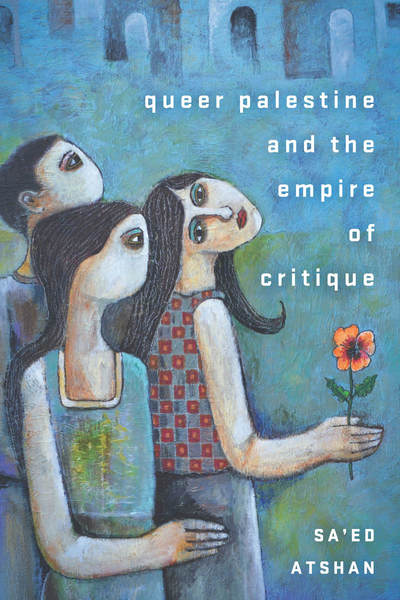Download PDF: Kiriakos-Fugate RV, Queer Palestine
By Sa’ed Atshan
Redwood City, CA: Stanford University Press, 2020. 296 pages. $28.00
In Queer Palestine and the Empire of Critique, Sa’ed Atshan writes about queer activism of and in solidarity with queer Palestinians. His book documents queer Palestinian resistance against homophobia and colonialism, two complex institutionalized systems of oppression that he shows to be enmeshed with one another. Atshan observes that contemporary queer Palestinian activism has plateaued due to the immense challenges from the Israeli state. Activism has also stalled due to a kind of criticism internal to the movement. He refers to this criticism as an “empire of critique,” revealing a problematic discourse that polices the borders of queer Palestinian activism.
Atshan has divided his work into five chapters. Chapter 1 builds on his introduction in providing the context to his work. He establishes the theoretical underpinnings of his ethnographic approach as well as introducing the heterogeneity of queer Palestinians and a history of Al-Qaws and Aswat, two contemporary queer Palestinian organizations. This chapter also justifies his commitment to a “politics of the ordinary,” whereby resistance happens in everyday life under extraordinary contexts of homophobia and apartheid (28). Chapter 2 addresses pinkwashing, a type of colonial propaganda that is a central concern for queer Palestinian activists. Operating through homonationalism, pinkwashing leverages gay—and sometimes trans—rights as evidence for Western superiority over that of purportedly intolerant minorities, thus justifying their subjugation by the state. Athsan presents several key examples and shows how pinkwashing upholds oppressive state policies. Accusations of pinkwashing can also appear within the empire of critique as a means of policing activism against the Israeli state. For example, queer social justice activists have at times accused fellow activists of pinkwashing when they address homophobia within Palestinian communities. Addressing these dynamics, Atshan convincingly argues that one can critique the politics of pinkwashing while also critiquing homophobia in both Israeli and Palestinian contexts.
In Chapter 3, Atshan builds on the previous chapter and focuses on issues of pinkwashing within transnational activism. Pride parades and other queer celebrations have become sites of conflict when issues of pinkwashing/pinkwatching (the process of deconstructing pinkwashing) arise in relation to funding, organizers, and entertainment. He draws from Andrew Robinson and Mikhail Bakhtin to understand these conflicts, arguing that schisms between activists reveal a kind of radical purism or monoglossia, whereby a singular voice is privileged as representative of a movement that is, in reality, far more complicated. In Chapter 4, Atshan shifts from pride parades to queer representation, documenting and analyzing representations of LGBTQ Palestinians in the media and in film. In general, Palestinians and those in solidarity with them distrust the media to such an extent that activists often critique most portrayals of queer Palestinians. Atshan argues that this trend of distrust becomes a problem when it unintentionally silences more nuanced representations. Overcoming this impulse within the movement means that demands for better media representation should center the complexities of queer Palestinian experiences rather than an unrealistic monolithic experience.
Chapter 5 continues to discuss the empire of critique but through the context of academia. Atshan asks that his fellow academics to be more cognizant of which voices they amplify and which they marginalize or ignore. Much of this self-reflective writing on academia reminds me of Kecia Ali’s work in the realm of Islamic studies, writing about the politics of citation as it relates to gendered authority in academia. [1] Atshan’s book is a contribution to these emerging conversations on citation and voice. This final chapter also reiterates his primary purpose of highlighting the inseparability of Zionism from homophobia, what Atshan labels as the “ethnoheteronormativity” that queer Palestinians experience and resist. The empire of critique undermines the complex realities of lives, oppressions, and protests. Ultimately, social justice requires “holding multiple, interconnected struggles together at once and to welcome a variety of differently positioned actors into the movement” (140). Activism, for him, can only truly be effective when it opens up space for solidarity between a multiplicity of voices, experiences, subjectivities, and ideologies. Crucially, this does not mean critique is bad; rather, any critique should lift up the marginalized and oppressed, not silence them.
Atshan’s conclusion reads as a manifesto, tasking his fellow academics to maintain best practices when writing about subaltern populations and individuals. Scholars should not impose, for example, a queer discourse onto the subjects of their research in what Atshan refers to as a type of “epistemic coercion.” Nor should we ignore intersectional realities by expecting individuals and communities to trade queer politics for anti-imperialist politics or vice versa (213). My only substantial criticism is his lack of attention to the ways religious identities and practices inform the lives of his informants. He acknowledges this limitation in the conclusion. He suggests that this is one direction future scholarship on LGBTQ Palestinian movements, individuals, and organizations can take. Religious studies has a lot to offer in this regard. Most importantly, religious studies can interrogate the role of Islamophobia and how it affects the lives of both queer Palestinian Muslims and Christians in ways that are most surely just as complex as being ethnic and sexual minorities under an apartheid state.
In my view, Queer Palestine’s most meaningful contribution is to academic conversations on social justice theory that build upon Kimberlé Crenshaw’s concept of intersectionality.[2] Atshan’s central message is that oppression and resistance are complicated because the lives of the oppressed and those who resist oppression are complicated. There is no separating out racialized experiences from those that are supposedly only homophobic experiences. This intersectional reality also means that activism is complicated. As Atshan argues throughout, there is no singular queer Palestinian experience because the lives of queer Palestinians are informed by their varying and unique encounters with homophobia in Israel, homophobia in the West Bank and Gaza, the legal, social, and militarized effects of a Zionist state, and the transnational phenomena of homonationalism and pinkwashing. Queer Palestinian struggles with homophobia and transphobia cannot be understood without also acknowledging the ways their experiences with racism inform those struggles. This is because Israel’s state-sanctioned Zionism justifies an ethnocracy that privileges white European Jewish Israelis. Simultaneously, Zionism also privileges the rights of heterosexual and cis-gendered citizens. Dividing up queer Palestinian experiences as either queer or Palestinian conceals the ways their oppression and their resistance work. Over all, writing on Palestinian experiences of and resistance to ethnoheteronormativity attests to the continuing relevance and elaboration of Crenshaw’s critical race theory.
Given Atshan’s personal and scholarly commitments to the movement of queer Palestinian liberation, Queer Palestine reveals itself to be a labor of love. His personal and ethical commitments to Palestinian and queer social justice comes through in his writing. What I admire most is his seamless ability to create a work that engages academics, social justice advocates, and those of us who balance both spheres in our everyday lives. Scholarship and social justice are not mutually exclusive, especially when our work as scholars concerns commitments both personal and ethical. In the same way that queer Palestinian liberation is tied to the struggle against Israeli apartheid, so too is our scholarship tied to the flourishing of those lives that we document in our books.
Notes
[1] Kecia Ali, “The Politics of Citation,” GenderAvenger, May 31, 2019. https://www.genderavenger.com/blog/politics-of-citation.
[2] Kimberlé Crenshaw, “Demarginalizing the Intersection of Race and Sex: A Black Feminist Critique of Antidiscrimination Doctrine, Feminist Theory and Antiracist Politics,” The University of Chicago Legal Forum, 1989.





